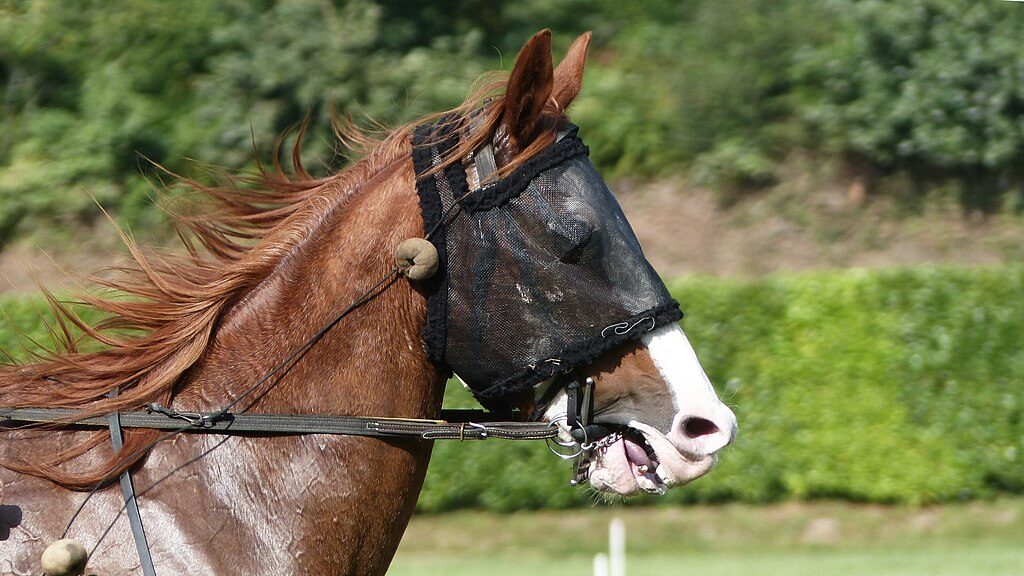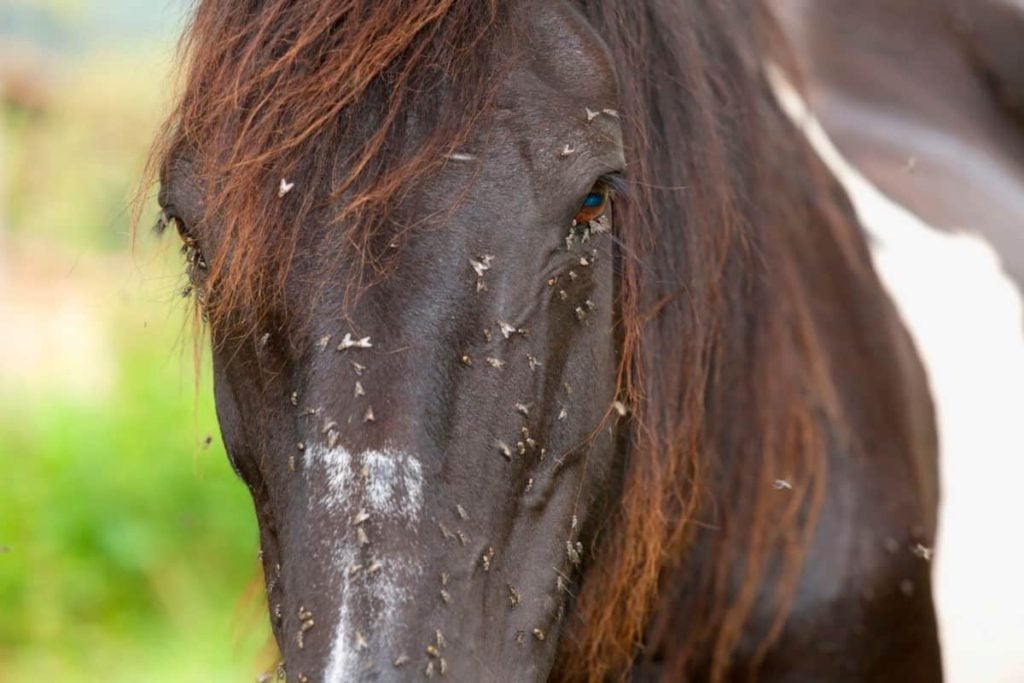Last updated: February 28, 2024
Any links on this page that lead to products on Amazon are affiliate links and I earn a commission if you make a purchase. Thanks in advance – I really appreciate it!
Horseflies are more than just a nuisance for horses and their owners. Their bites can lead to serious health issues and discomfort for your equine companions. My journey with horses has instilled in me the importance of understanding and managing the risks associated with horsefly bites.
This guide delves into the biology, behavior, and effective management strategies for horseflies, offering insights from recent studies and expert opinions to arm you with the knowledge needed to protect your horses.

The Biology and Behavior of Horseflies
Horseflies, belonging to the Tabanidae family, require blood to nourish their eggs, posing a concern for animals and humans alike. With over 4,450 species worldwide and about 400 in the U.S., they thrive in wet areas for breeding.
These insects, larger than common houseflies, feature large eyes, segmented antennae, and blade-like mouthparts for cutting through skin. Male horseflies feed exclusively on nectar, while females require blood for egg development.
This need turns them into aggressive biters during mating season, coinciding with summer – a time when humans and animals are more likely to encounter them.
Expert Insights on Horsefly Management
Key strategies for managing horsefly populations include environmental management, protective measures, and innovative traps. Immediate treatment for bites involves cleaning the area, applying a cold compress, and using over-the-counter medications to prevent infection.

Practical Solutions for Horse Owners
Commercial Repellents: Choose products with ingredients like permethrin and pyrethrin for their effectiveness.
DIY Remedies: Mix apple cider vinegar with water and essential oils like eucalyptus or citronella for a natural repellent.
Environmental Control Strategies

Barn and Pasture Management: Regular cleaning and water management can deter horseflies.
Use of Traps and Barriers: Traps that mimic animal heat and movement can reduce horsefly numbers.
Protection Against Horseflies
Horsefly Masks and Sheets: Essential gear like masks and sheets protect horses from bites, with some offering UV protection.
Fly Boots and Wraps: Protect the lower legs from irritation caused by horseflies.
Case Studies and Real-world Applications
Integrated Approach in a Horse Farm: Combining environmental management, repellents, and DIY solutions led to a significant reduction in horsefly populations.
Natural Solutions in a Small Stable: Employing homemade repellents and strategic pasture management effectively controlled horseflies with minimal chemical use.
Success Stories
Water Management Triumphs: We implemented a water management system which decreased the amount of standing pools. This significantly reduced horsefly populations, leading to healthier horses.
Vegetation Control Victories: Keep our grass cut short near the horse barn disrupted the horsefly habitats, resulting in fewer horseflies.

Understanding Horseflies: Key Facts for Horse Owners
Horseflies have coexisted with horses for centuries, requiring blood for egg production. They are attracted to movement and darker colors, thriving in moist environments. Managing these breeding grounds is crucial for controlling their population.
Protection Gear for Your Horse

Equip your horse with masks, sheets, and wraps to protect against horseflies. Opt for lighter colors and ensure the right fit for maximum protection.
Protection for Humans
Wearing light-colored clothing and using repellent sprays can help prevent horsefly bites. Seek medical attention for unusual symptoms or signs of infection.
This content, streamlined for mobile users, focuses on key information without redundancy, ensuring accessibility and ease of navigation on small screens.

FAQs for “Managing Horsefly Bites on Horses”
How often should I apply repellent to my horse?
The frequency depends on the type of repellent used. Some commercial repellents offer long-lasting protection, while natural, homemade repellents may require more frequent application. Always follow the product’s instructions.
What are the best methods to prevent horsefly bites?
Effective methods include using repellents, fly sheets, and masks for your horse, managing the environment to eliminate breeding grounds, and using horsefly traps.
Are certain horses more susceptible to horsefly bites than others?
Horseflies are attracted to movement and dark colors, so darker horses might experience more bites. However, all horses are susceptible, especially in environments conducive to horseflies.
Conclusion: Navigating Horsefly Bites on Horses
In wrapping up our detailed exploration of horsefly bites and their management, let’s revisit the essential insights that empower us to safeguard our equine friends effectively:
- Understanding Horseflies: Grasping the biology and behavior of horseflies lays the groundwork for their effective management.
- Impact on Horses: Recognizing the physical and behavioral impacts of horsefly bites enables prompt and suitable interventions.
- Scientific Insights: Applying the latest research and veterinary insights is vital for crafting informed management strategies.
- Treatment and Prevention: Prioritizing immediate care and adopting preventive strategies are crucial for defending horses against horsefly bites.
- Practical Solutions: Employing a mix of DIY remedies, commercial products, and environmental tactics offers a comprehensive defense strategy.
- Real-world Applications: Insights from success stories and expert advice illuminate the path to adopting the most effective management practices for our specific circumstances.
As dedicated horse owners and caretakers, our commitment to staying informed and proactive is key to maintaining the health and happiness of our horses. While the challenge of horseflies is persistent, armed with the right knowledge and resources, we are well-equipped to tackle it head-on.
Engage and Learn
Your experiences and strategies in managing horsefly bites are invaluable to our community. Sharing your insights not only enriches our collective knowledge but also supports others in finding effective solutions. We encourage you to contribute your stories and questions.
Stay Connected
- Join Our Community: For more insights and updates, consider subscribing to our newsletter. Your journey in horse care is important to us, and we’re here to support it with valuable information.
- Get in Touch: For personalized advice or specific questions, don’t hesitate to reach out directly. Your learning journey is our priority, and we’re here to assist you every step of the way.
Poll Question
List of References
- Understanding Horseflies:
- “Why Do Horseflies Bite & Will They Chase You?”: https://horseracingsense.com/why-do-horseflies-bite-will-they-chase-you/
- Expert Insights on Horsefly Management:
- WebMD’s “What to Know About Horseflies”: https://www.webmd.com/a-to-z-guides/what-to-know-about-horseflies
- Scientific Insights into Horsefly Bites:
- Study on horsefly behavior and attraction: https://royalsocietypublishing.org/doi/full/10.1098/rspb.2009.2202
- Diseases Transmitted by Horseflies:
- Equine Infectious Anemia information: https://www.aphis.usda.gov/aphis/ourfocus/animalhealth/animal-disease-information/equine/eia/equine-infectious-anemia
- DIY Remedies for Horsefly Bites:
- Homemade horse fly sprays: https://horseracingsense.com/homemade-horse-fly-sprays/
- Protection Gear for Horses:
- Information on horsefly masks and sheets: https://horseracingsense.com/why-do-some-horses-wear-blankets/
- Guide to choosing fly boots and wraps: https://horseracingsense.com/horse-fly-masks-boots-work-best/
Additional Resources
For further reading and resources, we encourage you to explore the following links:
- Latest Scientific Studies on Horsefly Behavior
- Veterinary Resources on Equine Health
- Comprehensive Review on Horsefly Reduction in Horse Facilities
Together, let’s continue to foster a community of informed, vigilant, and compassionate horse enthusiasts united in our commitment to the health and happiness of our beloved horses.

About the Author: Miles Henry
Lifelong Horseman | Racehorse Owner | Published Author
Miles Henry brings over 25 years of hands-on experience training and owning Thoroughbred racehorses. Raised with Quarter Horses and Appaloosas, he’s spent a lifetime learning from horses—on the track, in the barn, and in the field. Today, he runs a small but successful racing stable in Louisiana and shares real-world insights on HorseRacingSense.com, helping horse owners, fans, and bettors navigate the sport with confidence.
📚 Books: View Miles’s books on Amazon »
🎧 Podcast Guest: Animal Tales Ep. 32 |
YouTube Interview
📩 Newsletter: Sign up for racing tips and horse care advice »
🔗 Follow Miles:
Twitter |
Facebook |
YouTube

